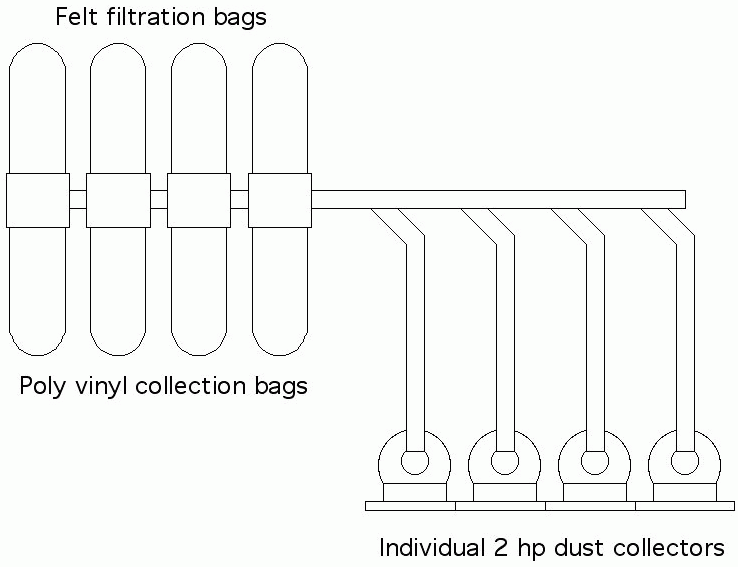Question
We recently installed eight 2hp dust collectors. Our machining area has a mezzanine over much of it, and these collectors serve just one machine each. The collectors shipped with 5 micron felt bags and cloth collector bags. We have upgraded most of them to custom felt bags from American Felt & Fabric and substituted poly vinyl bags for the cloth collector bags. The machines work just great! The evacuation on the stick shaper is flawless. There is absolutely no ambient dust on or around the powerfeed and cutterhead. We keep experimenting to see how far we can go with the pipe. Tomorrow we will complete a 30 foot run of 6 inch pipe that we hope will evacuate a 20 inch jointer. The real key to this success seems to be the new felt filter bags.
I just had an idea about how to enhance this air flow and I thought I would run it by the community. Please take a look at my sketch. My theory is that by combining air filtration for all of the individual units, the resistance per unit would go down and CFM go up. Each machine would have enhanced air filtration when running by itself and assistance when running in tandem with other dust collectors. The reason I went with the individual units was so that I did not have to calculate pressure drops, etc., and I did not want to run 10HP of collector to feed a 2HP saw. Does this seem too simple to work?

Forum Responses
(Dust Collection, Safety and Plant Operation Forum)
From contributor B:
As for the added air flow through the filtration bags, I think that is a great idea. However, as for the system actually working, I think there is a problem. When you turn on one of the blowers, it will pressurize the entire system. That means it will create back flow through the other blowers as well as through the filtration bag system. I think you'll end up sending shavings out through the other blowers as well as into the bag system. A way around this might be a check valve sort of gate at the exit of each blower. This could be hinged at the top and rest in a closed vertical position when the blower is not in use. When the blower is turned on, the air flow would swing the gate open. When the blower is not in use, the gate would block off the blower from the pressurized exhaust end of the system.
Or, the gate could have a solenoid driven opening mechanism that is simply tied into a 24v AC relay. Turn on the blower and the gate opens... just like on the after market systems you can purchase to automatically open the gates on individual machines.
What got me started on the whole idea was a custom felt bag we installed on the planer. A couple of years ago we installed a widebelt sander and shifted the 5 hp dust collector we had on the planer to the new widebelt. By default, the planer got a 2HP dust collector that was already in the building. The 2 HP collector was almost powerful enough, but not quite.
At the Seattle woodworking show we saw some custom size felt filtration bags by American Fabric & Felt Co. in Florida. It was only $100 or so to try the idea so we did. In the process, we also switched to a vinyl collector bag on the bottom. This new combination of collector and filtration bag made the 2HP collector seem like a 4HP collector. We were sold.
From there we made a purchase of (8) 2 HP collectors from Jet. These had been mispackaged with 5 micron bags, so we got a good deal on them. We set it up so that each machine would have its own collector and on some of the machines we installed new, bigger felt bags. We set it up with one machine/one collector for the reason of imbalanced air pressure that contributor R spoke of. What got me excited about the concept of integrating air filtration was the experience we had of more filtration = less resistance = better extraction. While up to four machines might be hooked up to one common collector, we were not trying to build an 8HP collector. Most of the time just one of the collectors would be running. I was just hoping that the extra bags would help us make longer runs. We have just completed a 30 foot run of six inch pipe to a 20 inch jointer.